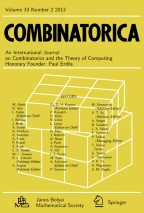Abstract
Let ℱ be a family of subsets of a finite set ofn elements. The vector (f 0, ...,f n ) is called the profile of ℱ wheref i denotes the number ofi-element subsets in ℱ. Take the set of profiles of all families ℱ satisfyingF 1⊄F 2 andF 1∩F 2≠0 for allF 1,F 2teℱ. It is proved that the extreme points of this set inR n+1 have at most two non-zero components.
Similar content being viewed by others
References
B. Bollobás, Sperner systems consisting of pairs of complementary subsets,J. Combinatorial Theory A15 (1973), 363–366.
G. F. Clements, A minimization problem concerning subsets of a finite set,Discrete Math.4 (1973), 123–128.
D. E. Daykin, J. Godfrey andA. J. W. Hilton, Existence theorems for Sperner families,J. Combinatorial Theory A17 (1974), 245–251.
P. Erdős, Chao Ko andR. Rado, Intersection theorems for systems of finite sets,Quart. J. Math. Oxford (2)12 (1961), 313–318.
C. Greene, G. O. H. Katona andD. J. Kleitman, Extensions of the Erdős—Ko—Rado theorem,SIAM55 (1976), 1–8.
G. O. H. Katona, Two applications of Sperner type theorems,Periodica Math. Hungar.3 (1973), (3) 19–26.
G. O. H. Katona, A simple proof of Erdős—Ko—Rado theorem,J. Combinatorial Theory B13 (1972), 183–184.
D. Lubell, A short proof of Sperner’s Lemma,J. Combinatorial Theory1 (1966), 299.
L. D. Meshalkin, A generalization of Sperner’s theorem on the number of subsets of a finite set,Teor. Verojatnost. i Primen.8 (1963), 219–220 (in Russian).
E. C. Milner, A combinatorial theorem on systems of sets,J. London Math. Soc.43 (1968), 204–206.
E. Sperner, Ein Satz über Untermenge einer endlichen Menge,Math. Z.27 (1928), 544–548.
K. Yamamoto, Logarithmic order of free distributive lattices,J. Math. Soc. Japan6 (1954), 343–353.
Author information
Authors and Affiliations
Additional information
Dedicated to Paul Erdős on his seventieth birthday
